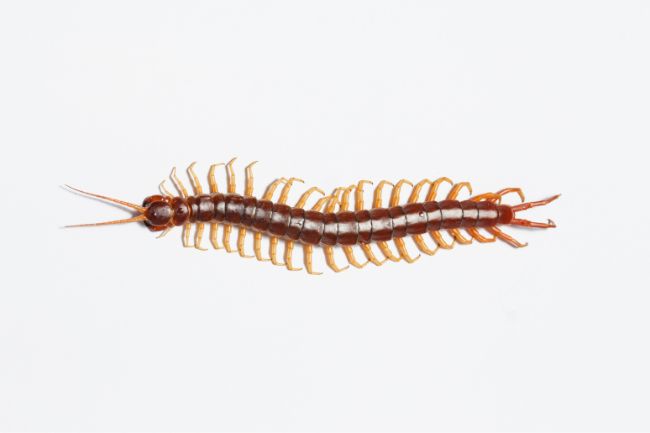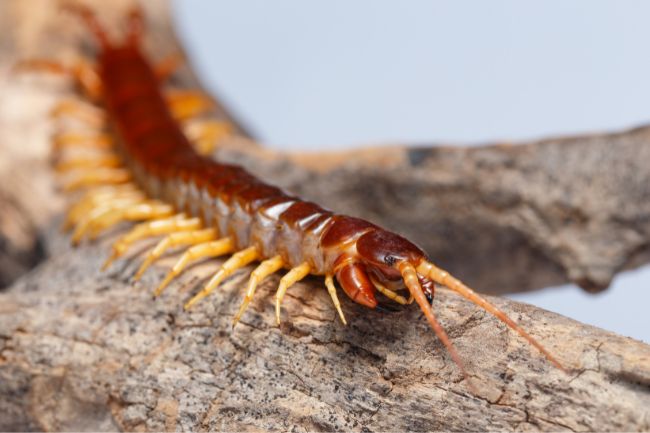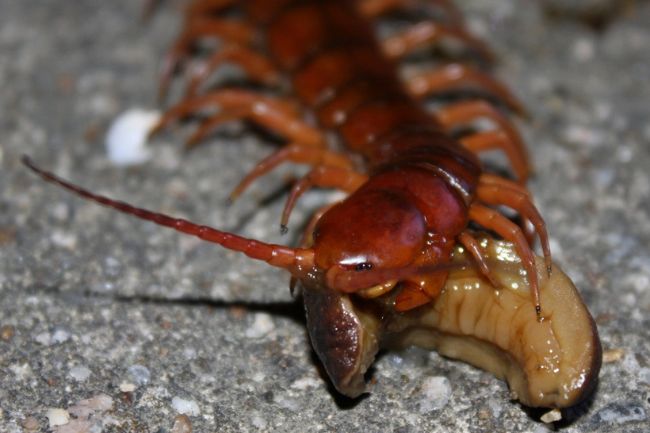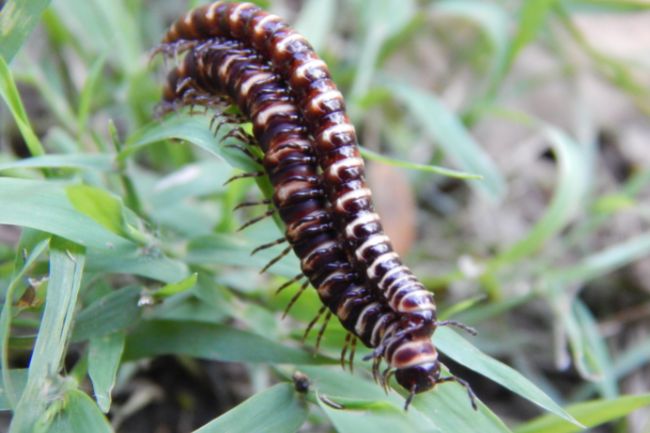Centipedes are nocturnal, meaning they are active at night rather than during the day. They do this for a variety of reasons, including the fact it is easier for them to avoid predators, easier to catch prey, and they are at less risk of drying out.
Contents
Are centipedes nocturnal?

The vast majority of centipedes are nocturnal, this means that they are active at night, rather than in the day. When we describe when an animal is most active, we generally characterise them as nocturnal, diurnal or crepuscular. Diurnal is for animals active in the day, whereas crepuscular means animals active at dawn and dusk.
Also read: Centipedes in Your Garden: Good or Bad?
| Centipede Species | Nocturnal Behavior |
|---|---|
| House Centipede | Active hunters at night, foraging for small insects and spiders. They are known for their quick movements and agility. |
| Giant Desert Centipede | Emerges at night to hunt small animals and insects. They are known for their venomous bite and are capable of subduing larger prey. |
| Stone Centipede | Nocturnal scavengers, feeding on dead insects and organic matter. They are commonly found in gardens and leaf litter. |
| Jungle Centipede | Active during the night, hunting small invertebrates. They are often found in tropical rainforests and have a venomous bite. |
| Vietnamese Centipede | Night-active predators, targeting insects and small arthropods. They have a potent venomous bite and are known for their aggressive behavior. |
| Amazonian Giant Centipede | Primarily nocturnal hunters, preying on various invertebrates. They are one of the largest centipede species and have a powerful venomous bite. |
| Bark Centipede | Active at night, feeding on small invertebrates and insects. They are well-camouflaged on tree barks and prefer forest habitats. |
| Red-Headed Centipede | Nocturnal predators, feeding on insects, spiders, and small invertebrates. They have a distinct red head and are found in woodland areas. |
What do they do at night?

When we use the term ‘active’ for animals, this tends to mean any time when they are not resting. Resting could be through sleep, inactivity or through deeper kinds of repose such as hibernation, diapause or torpor. When not at rest, animals can be catching food, playing and mating, depending on what their needs most require.
When it comes to centipedes, their time is spent in a fairly straightforward way. Most centipedes are not social, and will only interact with other centipedes in a significant way when they are looking to mate. Males do not take much part in family life after mating, though some females will raise their young until they can leave the nest.
Therefore, their time tends to be spent on a very small number of pursuits, in particular, hunting and mating.
Also read: Centipedes in Winter: What Happens With Them? Do They Like it?
Hunt

Centipedes are largely carnivores. Depending on the species, they can eat insects, spiders, molluscs, rodents, birds and amphibians, with giant centipedes being large enough to take down the latter. One of the reasons for the centipedes flat body, can be to help it squeeze through rocks and small openings in order to hunt down insects and other invertebrates.
Hunting at night can give them an advantage as their prey may be asleep, or not able to see them very well, which can prevent them from escaping quickly enough. In order to kill their prey, centipedes have a set of modified legs, that pierce their prey and inject venom. They can then use their large mandibles to chomp through their dead or paralysed prey.
| Prey Species | Nocturnal Prey |
|---|---|
| Spiders | Many spider species are active and abundant during the night, providing a significant food source for centipedes. |
| Insects | Various nocturnal insects, such as moths, beetles, and roaches, serve as common prey for nocturnal centipedes. |
| Worms | Some centipedes prey on earthworms and other nocturnal worm species that emerge at night. |
| Slugs and snails | Certain centipede species feed on slugs and snails, which are often more active during the night. |
| Larvae and pupae | Many insect larvae and pupae are active at night, serving as a nutritious food source for centipedes. |
| Small arthropods | Centipedes also target small arthropods, such as millipedes, isopods, and other invertebrates active at night. |
Another reason to hunt at night is that they themselves want to avoid predators. Most centipede species spend their time undercover, either under rocks, under rotting wood, or even burrowing through the ground. However, some species, such as giant centipedes, may spend their time wandering around above ground. There are many bird species, and mammals, who will eat a centipede, if they are able to grab them without being stung.
Many birds and mammals are adapted to life in the daylight, and at night are less able to spot our centipedes marching across the forest floor. Under the cover of darkness, our centipedes are therefore a little safer.
Also read: A List of Centipedes that are Poisonous to our Pets
Mate

Centipedes can live a surprisingly long time, some species reaching up to six years in age. However, in order for there to be more and more centipedes continuing on into the future, they need to find a partner to mate with.
Mating might seem like something that needs to be done in the light, in order to find and admire your love interest, but centipedes largely have very poor eyesight, and instead rely on their antennae to detect pheromones emitted by potential mates. Not only can the antennae help them follow these chemicals to their source, they can also use them to touch their beloved.
Using their antennae, male centipedes will often touch their partner. This courtship can go on for a long period of time, helping to create a bond between the pair. The male will have created a little silken packet of his sperm, for the female to collect and insert into her body in order to produce young.
Once his job is done the male departs, but many females will remain to care for the eggs, and sometimes even the young, until they are ready to leave the nest.
Also read: Wondering if “Millipedes have Antennae?” (Sensory Organ)
Why are centipedes nocturnal?
Most animals that live a nocturnal life do so for two reasons. Either living nocturnally helps them to avoid predators, or it helps them to be a better predator. For example, bats are thought to fly mostly at night, because day-flying birds are so much better at flying than them, and can easily pick them out of the air and eat them.
Many species of owls, by comparison, fly at night because it is easier to sneak up on their favourite prey, largely small rodents.
For centipedes, it’s likely to be a bit of both. Like many smaller arthropods, it’s very easy for them to be picked off by larger birds and mammals, as part of their general diet. Even with their venomous claws, many animals have learnt how to handle them with care so they can eat themselves without being harmed.
As many of the predators that eat them are inactive at night, this can be a great time to move around. They also have the added protection of the darkness to hide them away from prying eyes.
| Reasons | Explanation |
|---|---|
| Predatory advantage | Many prey species are active at night, providing ample hunting opportunities for nocturnal centipedes. |
| Avoiding predators | Some centipedes have predators that are more active during the day, so being active at night helps them avoid being preyed upon. |
| Temperature regulation | Nocturnal activity allows centipedes to avoid the heat of the day, as they prefer cooler temperatures for optimal functioning. |
| Moisture conservation | By being active at night when humidity levels are higher, centipedes can conserve moisture and prevent desiccation. |
| Sensory adaptation | Centipedes have specialized sensory organs that are more effective in low-light conditions, making them well-suited for night hunting. |
| Reproduction and mating | Some centipede species engage in courtship and mating behaviors at night, ensuring successful reproduction. |
| Habitat suitability | Nocturnal centipedes are often adapted to specific habitats that offer better opportunities for hunting and survival during the night. |
In terms of hunting, centipedes spend their time skittering around looking for prey. While they are much faster than their relatives, the millipedes, a head start could still help many of their potential victims to get away. Darkness can therefore assist them in sneaking up on those tasty morsels that might otherwise escape.
A third reason for operating largely at night is possible to avoid the heat of the day. Centipedes are at risk of drying out in hot and dry conditions, so they darkness can help to keep them damp in any difficult dry spells.
All in all, it’s easy to see why the centipede prefers the night. After all, with such bad eyesight, why would they even want to be out in the day? It’s easier, and safer, for these many legged creatures to keep to the night.
Also read: Millipedes and Centipedes – The Difference Explained

